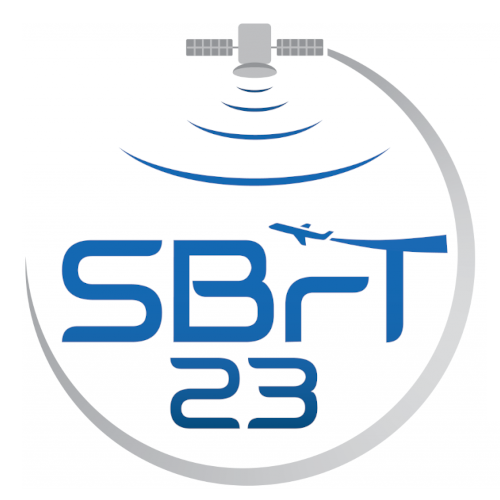
XLI Simpósio Brasileiro de Telecomunicações e Processamento de Sinais
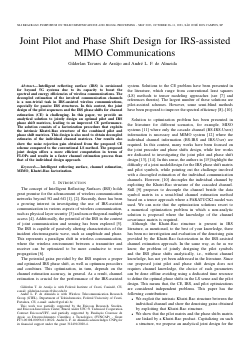
Joint Pilot and Phase Shift Design for IRS-assisted MIMO Communications
Gilderlan Tavares de Araújo, André de Almeida
DOI: 10.14209/sbrt.2023.1570923840
Keywords: Intelligent reflecting surface channel estimation Khatri-Rao factorization
Abstract
Intelligent reflecting surface (IRS) is envisioned for beyond 5G systems due to its capacity to boost the spectral and energy efficiencies of wireless communications. The decoupled estimation of the involved communication channels is a non-trivial task in IRS-assisted wireless communications, especially for passive IRS structures. In this context, the joint design of the pilot sequences and the IRS phase shifts for channel estimation (CE) is challenging. In this paper, we provide an analytical solution to jointly design an optimal pilot and IRS phase shift matrices, leading to an improved CE performance. The solution consists of a factorization procedure that exploits the intrinsic Khatri-Rao structure of the combined pilot and phase shift matrices. This design is also used to obtain decoupled estimates of the individual channel matrices. Our results also show the noise rejection gain obtained from the proposed CE scheme compared to the conventional LS method. The proposed joint design offers a more efficient computation in terms of FLOPs and results in a faster channel estimation process than that of the individual design approach.Download

Um estudo sobre o sincronismo em neurônios de Hindmarsh-Rose com sinapses químicas
Ricardo de Biazzi, Marcio Eisencraft
DOI: 10.14209/sbrt.2023.1570923846
Keywords: Neurônios de Hindmarsh-Rose Sistemas dinâmicos Sincronismo
Abstract
In this paper, we investigate the synchronization between the signals generated by two Hindmarsh-Rose neurons connected by a chemical synapse. We evaluate the synchronization error as a function of the synaptic connection intensity using computer simulations, in which synchronization and desynchronization phenomena were observed.Download
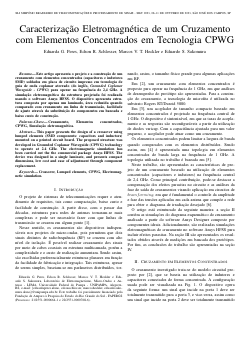
Caracterização Eletromagnética de um Cruzamento com Elementos Concentrados em Tecnologia CPWG
Eduarda Gomes Peres, Edson R. Schlosser, Marcos V. T. Heckler, Eduardo Sakomura
DOI: 10.14209/sbrt.2023.1570923849
Keywords: Cruzamento Elementos concentrados CPWG Simulação eletromagnética
Abstract
Este artigo apresenta o projeto e a construção de um cruzamento com elementos concentrados (capacitores e indutores SMD) soldados em placa de circuito impresso em tecnologia de guia de onda coplanar aterrado (do inglês, Grounded Coplanar Waveguide - CPWG) para operar na frequência de 2,4 GHz. A simulação eletromagnética da estrutura projetada foi realizada usando o software Ansys HFSS. O dispositivo apresenta estrutura composta por apenas um laminado, área reduzida quando comparado com cruzamento em linha de transmissão, facilidade de ajuste através da substituição de componentes em bancada e baixo custo de construção.Download
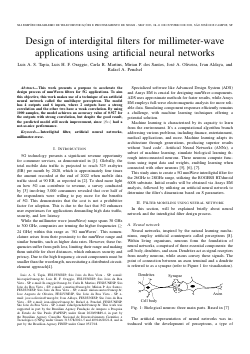
Design of interdigital filters for millimeter-wave applications using artificial neural networks
Luis Alexandre S Tapia, Luis H. F. Oraggio, Carla R. Martins, Ivan Aldaya, Mirian Santos, Jose Augusto de Oliveira, Rafael Abrantes Penchel
DOI: 10.14209/sbrt.2023.1570923850
Keywords:
Abstract
This work presents a purpose to accelerate the design process of mmWaves filters for 5G applications. To aim this objective, this work makes use of a technique of an artificial neural network called the multilayer perceptron. The model has 4 outputs and 6 inputs, where 2 outputs have a strong correlation and the other two have a weak correlation. By using 1000 samples, the model achieves an accuracy value of 0.927 for the outputs with strong correlation, but despite the good result, the predicted model still needs improvement, since \|S_{11}|\ had a not-so-nice performance.Download
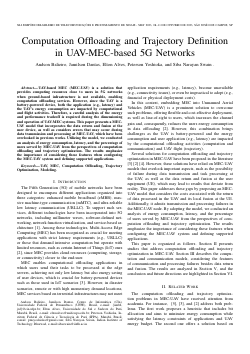
Computation Offloading and Trajectory Definition in UAV-MEC-based 5G Networks
Andson M Balieiro, Jamilson Dantas, Elton Alves, Peterson Marcelo dos Santos Yoshioka, Siba Narayan Swain
DOI: 10.14209/sbrt.2023.1570923852
Keywords: UAV MEC Computation Offloading UAV Trajectory Optimization
Abstract
UAV-based MEC (MEC-UAV) is a solution that provides computing resources close to users in 5G networks when ground-based infrastructure is not available, enabling computation offloading services. However, since the UAV is a battery-powered device, both the application (e.g., latency) and the UAV's energy consumption are impacted by computational and flight activities. Therefore, a careful analysis of the energy and performance tradeoff is required during the dimensioning and operation of UAV-MEC systems. This paper presents a MEC-UAV model that incorporates the data return and fusion at the user device, as well as considers errors that may occur during data transmission and processing at MEC-UAV, which have been overlooked in previous works. Utilizing the model, we conducted an analysis of energy consumption, latency, and the percentage of users served by MEC-UAV from the perspectives of computation offloading and trajectory optimization. The results emphasize the importance of considering these features when configuring the MEC-UAV system and defining supported applications.Download
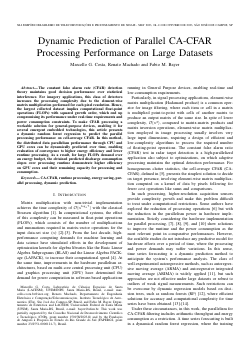
Dynamic Prediction of Parallel CA-CFAR Processing Performance on Large Datasets
Marcello G. Costa, Renato Machado, Fabio Bayer
DOI: 10.14209/sbrt.2023.1570923860
Keywords: CA-CFAR runtime processing energy saving parallel process
Abstract
The constant false alarm rate (CFAR) detection theory maintains good decision performance over statistical interference. For imagery applications, this class of detectors increases the processing complexity due to the element-wise matrix multiplication performed for each pixel resolution. Hence, the largest collected dataset implies computational float-point operations with squared growth order, which end up compromising its performance under real-time requirements and power consumption constraints. To make the CFAR processing a workable solution for General Purpose devices, enabling it for several emergent embedded technologies, this article presents a dynamic prediction of parallel cell-average CFAR model with energy and runtime processing constraints. Distributing the processing through CPU and GPU cores, the convergence to higher energy save and lower runtime processing is achieved and measurable, with the discharge slopes as a function of element-wise matrix products dynamically predicted.Download
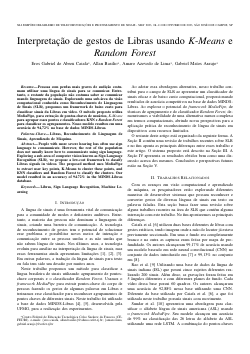
Interpretação de gestos de Libras usando k-means e Random Forest
Eros Caiafa, Allan Basilio, Amaro de Lima, Gabriel Araujo
DOI: 10.14209/sbrt.2023.1570923868
Keywords: Libras SLR Aprendizado de Máquina
Abstract
Pessoa com perdas mais graves de audição costumam utilizar uma língua de sinais para se comunicar. Entretanto, o restante da população não costuma saber se comunicar usando linguagens de sinais. Explorando uma sub-área da visão computacional conhecida como Reconhecimento de Linguagens de Sinais (SLR), propomos um framework de baixo custo para classificar sinais Libras em vídeo. O método proposto utiliza MediaPipe, para extração de pontos-chaves de usuários, k-Means para agrupar esses pontos e classificadores k-NN e Random Forest para classificar os agrupamentos. Nosso modelo resultou em uma acurácia de 94,72% na base de dados MINDS-Libras.Download
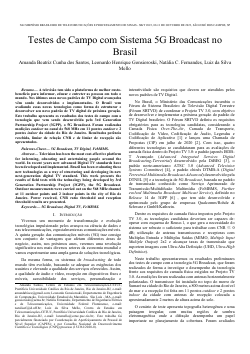
Testes de Campo com Sistema 5G Broadcast no Brasil
Leonardo Henrique Gonsioroski, Amanda Beatriz Cunha dos Santos, Natalia Fernandes, Luiz da Silva Mello
DOI: 10.14209/sbrt.2023.1570923871
Keywords: 5G Broadcast TV Digital FeMBMS
Abstract
Television has been the most cost-effective platform for informing, educating and entertaining people around the world. In recent years new advanced Digital TV standards have been developed and implemented. Brazil has been evaluating these new technologies as a way of structuring and developing its new next-generation digital TV standard. This work presents the results of field tests with the technology being developed by 3GPP, the 5G Broadcast. Outdoor measurements were carried out on the 568 MHz channel at 11 outdoor points and 2 indoor points in the city of Rio de Janeiro. Coverage, C/N ratio threshold and reception threshold results are presentedDownload
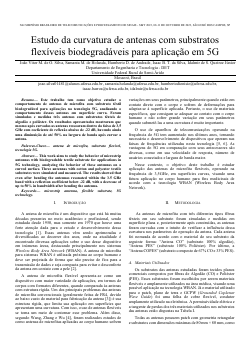
Estudo de antenas com substratos flexíveis biodegradáveis para aplicações em 5G
João Vitor Macedo de Oliveira Silva, Samanta de Holanda, Humberto Dionísio de Andrade, Isaac B. T. da Silva, Idalmir de Souza Queiroz Junior
DOI: 10.14209/sbrt.2023.1570923904
Keywords: antena de microfita substrato têxtil tecnologia 5G antena flexível
Abstract
Este trabalho tem como objetivo estudar o comportamento de antenas de microfita com substrato têxtil biodegradável para aplicações na tecnologia 5G, analisando o comportamento dessas antenas em superfície curva. Foram simuladas e medidas três antenas com substratos têxteis de algodão e poliéster. Os resultados apresentados mostraram que mesmo após curvadas as antenas ressoaram dentro da faixa de 3,5 GHz com coeficiente de reflexão abaixo de -22 dB, havendo ainda uma diminuição de até 50% na largura de banda após curvar a antena.Download